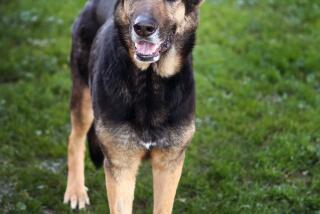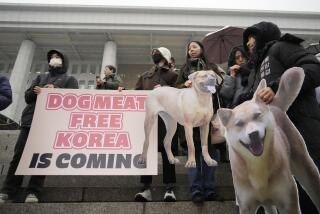Streets of Moscow Are Going to the Dogs
- Share via
MOSCOW — Just when it seemed the streets of Moscow couldn’t get any meaner, a new menace has appeared from what used to be a source of comfort.
The people of this troubled capital are being hounded by proliferating hordes of dogs--numbering in the tens of thousands--that have been abandoned by the poor, abused by the angry, taunted by the ignorant and trained to kill by the rich.
The canine population of Moscow has exploded as fearful residents have turned to guard dogs in the absence of reliable police protection and the lonely and luckless take in pets for companionship they soon discover they cannot afford.
Add to the grim scenario the collapse and corruption of the Soviet-era dog-catching system and the transitory chic for nouveau riche Russians to flaunt pedigree breeds, and the cause of the new threat is clear.
“It’s nothing less than a testimony to the moral and social decline of Russia!” declares Tamara Shibayeva, a groomer who has spent more than 30 years pampering Moscow’s most privileged pooches. “Today, people don’t look at their pets as members of the family. They are either for show or for protection, and as soon as they no longer want that service, they are just thrown out like garbage.”
Moscow has a leash law but no effort at enforcement. With no threat of fines and little concern for the complaints of neighbors, many dog owners let their pets run loose, leaving them to snarl and snap at strangers.
Dog bites have more than tripled in Moscow over the past few years, with more than 40,000 attacks requiring doctors’ treatment or hospitalization last year, according to statistics compiled by the State Health Inspectorate. Many times that number of milder bites are thought to have occurred without official registration.
“I don’t walk my dogs at night anymore. I just take them outside my apartment door for a minute before I go to bed,” Irina Grech, head of the Moscow Dog Lovers Assn., says as one of her four boxers, Theo, snuffles and snores under her clubhouse desk. “It’s terrible--all these dogs roaming around in packs, some of them sick or wounded from mistreatment. It breaks your heart because it’s not the fault of the dogs, it’s the fault of those who once owned them.”
Some of the homeless hounds have been abandoned by speculators who trained them for fighting before the practice was banned by the Moscow Sports Committee more than two years ago. Until the edict that has chased such blood sport underground, the Russian Pit Bull Owners Assn. and other groups cultivating attack dogs held outdoor battles in public parks--sometimes to the death--for paying audiences.
Viktor Gusakov, director of an animal clinic and kennel in southern Moscow, estimates that 10% of the strays are pedigree dogs cast out by owners who acquired them for speculative purposes, either to breed for sale in fickle markets or to train for personal defense or illegal fights.
Most, though, are the offspring of other strays left to breed indiscriminately.
Veterinarians throughout Moscow complain that the municipal government pays so little to its meager force of dogcatchers that the jobs attract only alcoholics and petty criminals who use their position to kidnap obviously cared-for pets that they can hold for ransom.
“We have dog-catching services, but not like in the West,” laments Lilya Barbashova, a veterinarian who has worked in the capital for more than four decades. “Here, they only catch dogs if they think it will bring them money.”
While the soaring dog population spurs wails and curses, even from attentive owners, some find it a positive sign.
Barbashova believes there has been a correspondingly huge increase in the number of loved and well-treated pets as more Muscovites achieve financial security and can afford the luxury of a friendly mouth to feed.
“Many people in Moscow are starting to live better. You can see this in the shops. There are now more products for the pet world than there used to be for people,” she says.
Nearly every kiosk and corner grocery now stocks dog and cat food along with its human staples, and dozens of specialty shops selling everything from gem-studded collars to vaccines against rabies have cropped up to cash in on the booming business.
The old Bird Market that used to be the venue of weekend sales of scruffy kittens, hamsters, parakeets and puppies has been bought from the city government by a group of pet enthusiasts and converted into a commercial emporium offering every imaginable product and service for man’s best friends.
Dog “hotels”--a.k.a. kennels--are the newest arrivals on the pet scene, although operators complain that their premises have quickly become popular places for abandoning unwanted dogs.
One gauge of the dog mania is the year-old weekly television program “My Dog and I,” a half-hour collection of service tips, health advice and talent contests rivaling David Letterman’s “Stupid Pet Tricks.”
Scriptwriter Mikhail Shirvindt insists with all sincerity that the idea for the program came from his English cocker spaniel, Sandrik.
“We were trying to brainstorm some new show ideas about 18 months ago when Sandrik came up to me and put his paws on my lap and just stared me into the decision,” says the youthful co-creator of the popular series broadcast nationwide by Independent Television. “My dog takes my mind off the many troubles in the world, and we created this show with the aim of giving viewers something to smile about for a change.”
Shirvindt expressed heartache that strapped pensioners are increasingly compelled to give up their beloved pets as the cost of caring for them soars to Western levels in a society where the average worker earns less than $100 a month and many retired people exist on $20 or $30.
Some scrappy Muscovites wave off the financial deterrents and get by the old-fashioned way--by the wiles and cajoling and favor-trading that kept society moving in the Soviet era.
Grech, of the dog lovers league, advises friends and neighbors to cozy up to neighborhood restaurant workers and butcher shop owners to get food scraps and bones.
There is also the power of devotion that mere economic reality is helpless to contend with.
Yelena Rukosuyeva, 38, lives with her mother and two giant Afghans in a pair of minuscule rooms that together offer only 120 square feet of living space. She supports the close-quartered foursome on a 500,000-ruble monthly salary from her film-editing job, a sum equal to about $105.
How much does it cost to feed two full-sized and finicky Afghans in a typical month?
“Let’s see,” Rukosuyeva ponders, pulling out a calculator to add up the price for each pound of imported food she goes through. “About 300,000 rubles.”
More than half her total income? More than she spends to feed herself and her mother?
“I guess,” she says, giggling in embarrassment. “I never really did the math on this before.”
More to Read
Sign up for Essential California
The most important California stories and recommendations in your inbox every morning.
You may occasionally receive promotional content from the Los Angeles Times.














